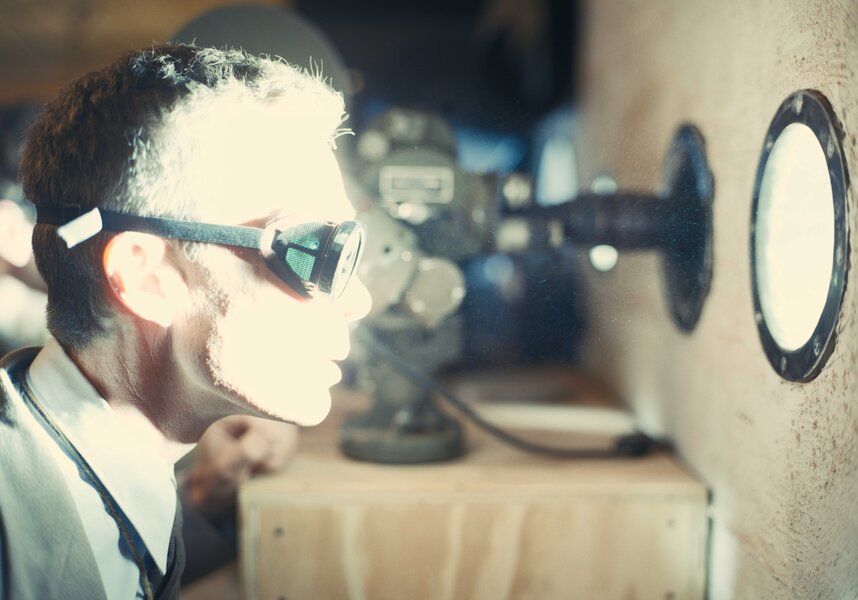Create a free profile to get unlimited access to exclusive videos, sweepstakes, and more!
Why Oppenheimer Doesn't Include the Deadly "Demon Core" Accidents
Two deadly incidents that were part of the Manhattan Project aren't in Oppenheimer — for good reason.
Christopher Nolan’s biopic Oppenheimer (now streaming exclusively on Peacock), about the man behind the creation of the atomic bomb, is a gripping, tense, and historically accurate blockbuster. Granted, not every aspect of the Manhattan Project was included.
Based primarily on the book American Prometheus: The Triumph and Tragedy of J. Robert Oppenheimer (the Pulitzer-winning biography written by Kai Bird and the late Martin J. Sherwin), the Oscar-nominated film takes a few liberties with what actually happened during the Manhattan Project and the aftermath of the Trinity Test — the specifics of Oppenheimer’s conversations with Albert Einstein, for example — but it doesn’t futz with the actual historical timeline much. That’s why the demon core, one of the more infamous and scary moments in the development of nuclear weapons, does not appear in Oppenheimer.
For More on Oppenheimer:
Oppenheimer's "Chilling" Final Scene Came to Christopher Nolan While Lying in Bed
Christopher Nolan's Oppenheimer Now Streaming Exclusively On Peacock With Making-Of Featurettes
Why There Are No Deleted Scenes in Oppenheimer
What was the Manhattan Project's demon core?
The ominously named demon core, a sphere of plutonium used in the development of atomic bombs after the success of the Trinity Test, was responsible for the deaths of two scientists who worked on the Manhattan Project. The core, which weighed 14 pounds and measured just 3.5 inches in diameter, was all set to be turned into a third bomb that could have been used against Japan had they not surrendered following the bombings of Hiroshima and Nagasaki in August 1945.
On August 21, 1945, six days after Japan surrendered and 12 days after the bombing of Nagasaki, the unused demon core (which had not yet earned its deadly moniker) was used in a test to see how close it was to criticality, meaning it would start a self-sustaining chain reaction, emitting massive amounts of radiation and power. Harry Daghlian, a 24-year-old physicist at Los Alamos, was performing a procedure intended to make the core close to criticality without actually starting the chain reaction. He was staking tungsten carbide bricks around the core to act as a reflective shield, but when he accidentally dropped one on the core, the impact prompted the core to go supercritical. Daghlian removed the dropped brick almost instantly, stopping the reaction, but it had already let out an immense amount of radiation. He died 25 day later of acute radiation syndrome.
Less than a year later, on May 21, 1946, Louis Slotin would become the demon core’s second victim. Slotin, a 35-year-old physicist, was performing another test to verify how close to criticality the core was. Slotin, known to be a bit of a showboat, was using a screwdriver to lift a half-sphere of beryllium around the core. If the two pieces of beryllium fully closed, completely encasing the core, it would cause it to go critical. As Slotin performed the test in front of a room of onlookers, his screwdriver slipped, allowing the half-sphere to fully fall. There was an instant flash of light, and although Slotin pulled the top off right away, the damage had already been done. Slotin would die nine days later. The position of his body is believed to have blocked several onlookers from getting as much exposure to radiation as they could have otherwise.
After these two incidents, the demon core was eventually melted down, as the second criticality accident had made it not ready for use in Operation Crossroads, the 1946 Bikini Atoll tests. It was melted down that summer; the plutonium was used for other cores.
Why isn't the demon core in Oppenheimer?
None of this is depicted in Oppenheimer. An earlier film about the Manhattan Project, 1989’s Fat Man and Little Boy, which stars Paul Newman as General Leslie Groves (played in Oppenheimer by Matt Damon), does play fast and loose with history in order to get the demon core in the narrative. John Cusack plays Michael Merriman, a fictional composite character who dies in a similar manner as Slotin would, although the accident happens before the Trinity Test or bombings of Japan. (Author's Note: Fat Man and Little Boy, it should be said, is not a very good movie, especially when compared to Oppenheimer.)
So why doesn’t Oppenheimer feature the demon core? The simplest answer is that the accidents happened after the Trinity Test, not before it. Even so, there’s an argument to be made that the film — much of which takes place after the test — could have addressed the accidents. However, that’s not where Oppenheimer’s focus is.
Neither Daghlian nor Slotin are in the movie, which is focused largely on the psychological and ethical ramifications of the creation of the atomic bomb, not the dangers of building one. For the film to have taken a detour to show two scientists dying might have made for a scary scene, but their deaths would have been a distraction from both Oppenheimer’s story and the impossibly large stakes. What is the death of two scientists compared to a chain reaction that might destroy the world?
Oppenheimer is streaming exclusively on Peacock.
































